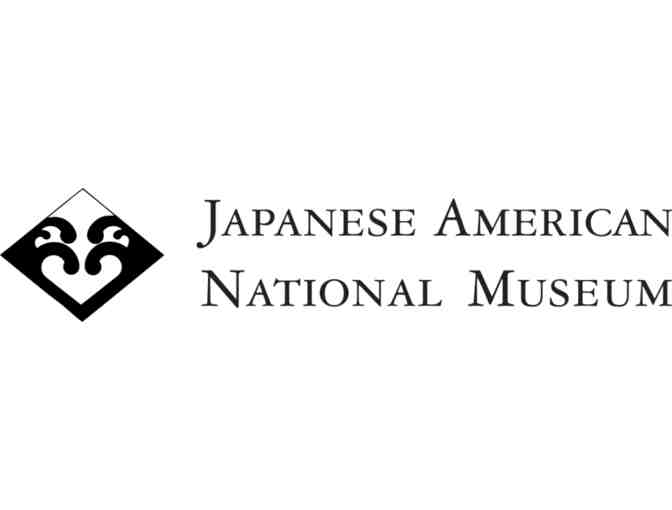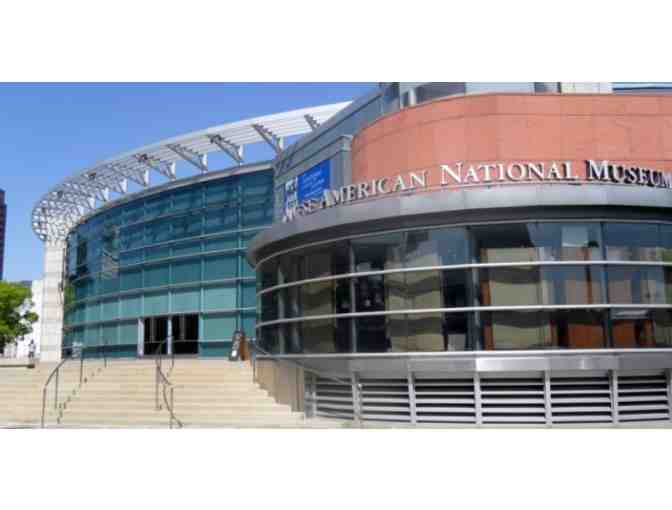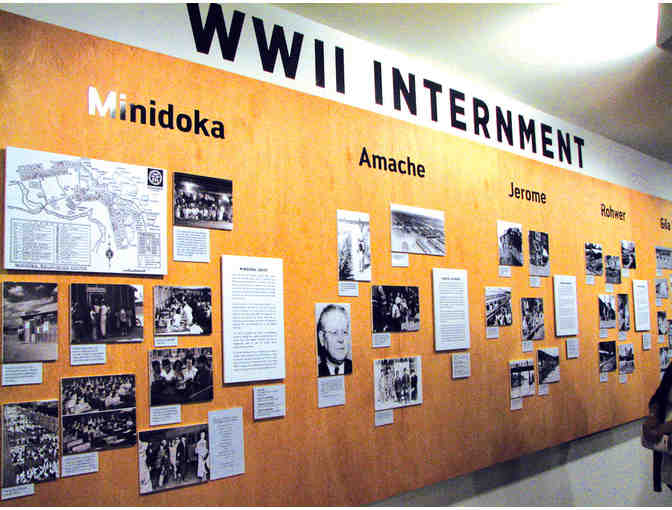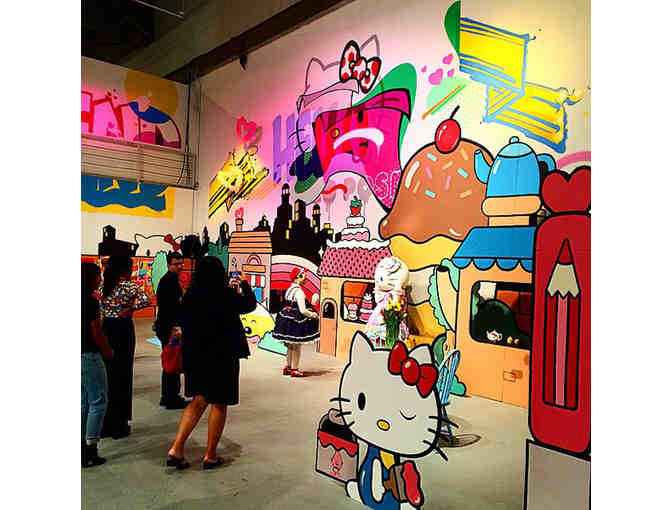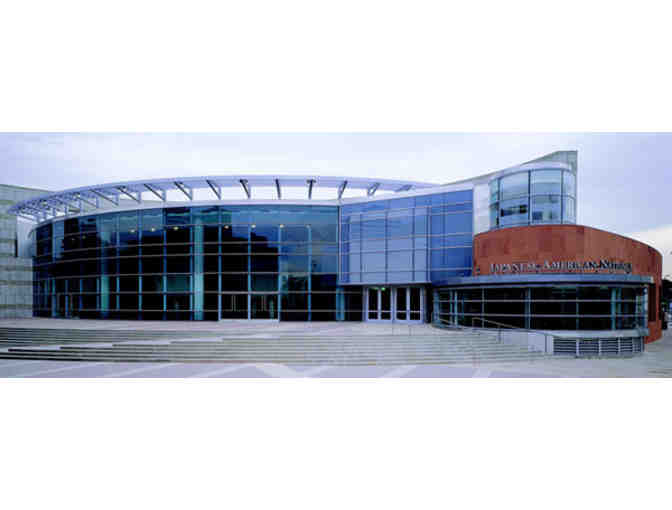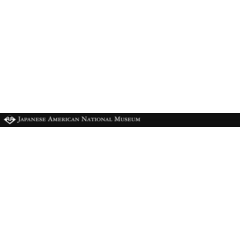Tickets-Entertainment
Japanese American National Museum - Family Admission Pass valued at $33
- Item Number
- 312
- Estimated Value
- 33 USD
- Sold
- 11 USD to dragonfly9
- Number of Bids
- 1 - Bid History
Item Description
Free Family Admission Pass. Good for up to two adults and three children under age 18. Valid for JANM admission only. Does not apply to specially ticketed exhibitions or events.
The mission of the Japanese American National Museum is to promote understanding and appreciation of America’s ethnic and cultural diversity by sharing the Japanese American experience.
The Japanese American National Museum is the first museum in the United States dedicated to sharing the experience of Americans of Japanese ancestry as an integral part of U.S. history. Through its comprehensive collection of Japanese American objects, images and documents, as well as multi-faceted exhibitions, educational programs, documentaries and publications, the National Museum shares the Japanese American story with a national and international audience.
The National Museum was established in Los Angeles to preserve the rich heritage and cultural identity of Japanese Americans. In 1982, businessmen in L.A.’s Little Tokyo began exploring the possibility of building a Japanese American museum, as did a separate group of highly decorated World War II veterans. A representative from the financial group proposed incorporating a museum into a planned Little Tokyo residential complex, while veterans of the famed 442 nd Regimental Combat Team sponsored a “Japanese American Soldier” exhibition at the Los Angeles Country Museum of Natural History.
The two groups soon joined forces, and in 1985 the Japanese American National Museum was incorporated as a private, nonprofit institution. Over the next several years, volunteers sought backing from community groups. In 1985, California State Senator Art Torres introduced a funding bill that acknowledged the major contributions Japanese Americans have made to the social, cultural and economic spheres of California, and the state legislature soon appropriated $750,000 toward the Museum on the condition that Los Angeles provide matching funds. At the urging of the volunteer corps, the City of Los Angeles granted a $1 million match the following year.
Seeking to safeguard the rich oral histories of first generations immigrants, or Issei, and the artifacts, photographs, written records and other materials documenting the lives of Japanese Americans before, during, and after the World War II mass incarceration, National Museum founders enlisted the support of the Japanese American community. In 1992, the Japanese American National Museum opened its doors to shed light on the Japanese American experience—a process of immigration and re-settlement common to so many Americans.
Built by Japanese immigrants in 1925, the National Museum’s renovated historic building was the first structure designed specifically in Los Angeles to house a Buddhist place of worship, the Nishi Hongwanji Buddhist Temple. The ornate building incorporates elements of a temple in Kyoto, combining Japanese and Middle Eastern influences in its striking façade. The temple originally served as a house of worship, social hall and rental office space. A central gathering place in thriving Little Tokyo, the structure was later used to store the belongings of Japanese Americans sent to U.S. concentration camps during World War II. The building eventually fell into disrepair after the Nishi Hongwanji moved to a new facility in 1969, and was sold to the City of Los Angeles in 1973. Declared a landmark by the City, it became the long-awaited space for the Japanese American National Museum.
Since the opening of its historic site in 1992, the Japanese American National Museum has continued to fulfill its mission through historical exhibitions (Issei Pioneers: Hawaii and the Mainland, 1885-1924) and art exhibitions (The View from Within: Japanese American Art from the Internment Camps, 1942-1945). As a community-based institution, the Museum has developed numerous regional exhibitions and programs in partnership with other communities and museums, including In This Great Land of Freedom: Japanese Pioneers of Oregon, developed with the Oregon Japanese American community, and shown at the Oregon Historical Society and numerous museums throughout the Pacific Northwest. Other examples include The Kona Coffee Story, which was developed in partnership with the Japanese American community in Kona, Hawai‘i, and toured throughout Hawai‘i and in Brazil. The exhibition From Bento to Mixed Plate: Americans of Japanese Ancestry in Multicultural Hawai‘i was developed with the National Museum’s Hawai‘i Advisory Council and included a community education component in partnership with the Hawai‘i State Education Department. The Museum’s exhibitions have traveled to the Ellis Island Immigration Museum in New York City (America’s Concentration Camps: Remembering the Japanese American Experience-1998), the Smithsonian in Washington, D.C. (From Bento to Mixed Plate: Americans of Japanese Ancestry in Multicultural Hawai‘i-1999), and to Brazil (The Kona Coffee Story-1998). From Bento to Mixed Plate also toured Japan.
The National Museum opened its new 85,000 square-foot Pavilion to the public in January 1999. The City of Los Angeles contributed a one-acre site for the Pavilion at $1 per year on a 55-year lease. The contemporary stone, steel and glass Pavilion bridges East-West aesthetic traditions by adjoining with the Museum’s original building. With the opening of the Pavilion, the National Museum premiered two major exhibitions: Common Ground: The Heart of Community and Bruce and Norman Yonemoto: Memory, Matter and Modern Romance. The former provides the broad outline of the history of Japanese Americans, while the latter represented the strong commitment to the arts. With generous grants from the Ford Foundation, the James Irvine Foundation and the Norton Foundation, the National Museum has broadened its activities in the presentation and preservation of Japanese American art, highlighting little known Nikkei artists such as Hisako Hibi, Henry Sugimoto, Hideo Date, Toshiko Takaezu and Ruth Asawa.
In 1999, the Museum organized the International Nikkei Research Project involving fifteen scholars and nine Nikkei institutions across the globe. The three-year project gathered research on the Japanese Diaspora and developed linkages between Japanese communities worldwide. Funded by the Nippon Foundation, the project brought together historians and researchers from Argentina, Paraguay, Canada, Peru, Brazil, Mexico, Japan and the U.S. where significant populations of Japanese have immigrated. The result was the publication of the first comprehensive history of the Japanese in the Americas in two books: New Worlds, New Lives: People of Japanese Descent in the Americas and The Encyclopedia of People of Japanese Descent in the Americas. Thanks to The Nippon Foundation, the National Museum premiered a multi-lingual Web site connected to the history of the Japanese throughout the world. DiscoverNikkei.org is a major resource of information and a place for people to share their experiences. DiscoverNikkei.org was named Best Research Site in 2007 and the project has organized many successful public programs, including a major gathering of Okinawans and those of Okinawan descent in 2008.
Other projects of note include the 2002 All-Camps Summit, which brought together scholars, government officials and former camp inmates and their families to share the lessons learned from the unconstitutional incarceration of Japanese Americans during World War II. That project was followed up with “Camp Connections: A Conversation about Social Justice and Civil Rights in Arkansas” held on September 2 3-25, 2004, in Little Rock, Arkansas. The conference was part of the Winthrop Rockefeller Foundation-funded Life Interrupted project, which sought to inform Arkansans about the fact that two camps were located in their state to house Japanese Americans during the war. The National Museum continued in this vein with the five-state project, Enduring Communities: The Japanese American Experience in Arizona, Colorado, New Mexico, Texas, and Utah. That culminated in a national conference, “Whose America? Who’s American? Diversity, Civil Liberties, and Social Justice”, held in Denver, Colorado, July 3-6, 2008. The conference, which drew over 1,000 participants, included panels and presentations related to the Civil Liberties Act of 1988, which provided for a government apology and redress for Japanese Americans, who were forcibly removed from their homes and businesses during World War II. It also presented various aspects of the Japanese American experience in the Enduring Communities’ participating states and how new curricula was being developed in each of the states to better teach these experiences.
In 2004, the National Museum, as an official affiliate of the Smithsonian Institution, featured two major shows from the Smithsonian: Isamu Noguchi and Modern Japanese Ceramics and September 11: Bearing Witness to History. It also installed George Nakashima: Nature, Form & Spirit, highlighting the work of one of America’s top furniture designers and woodworkers. Continuing that tradition in 2005, the National Museum installed another Smithsonian exhibition, Japan After Perry: Views of Yokohama and Meiji Japan and Lasting Beauty: Miss Jamison and the Student Muralists, which premiered in Arkansas as part of Life Interrupted. That was followed by Big Drum: Taiko in the United States, the first major exhibition on the tremendous growth of taiko ensemble performance, and Toshiko Takaezu: The Art of Clay, displaying the work of a Living Treasure from Hawai`i and New Jersey. In 2006, the National Museum installed the traveling exhibition, Isamu Noguchi–Sculptural Design, which was organized by the Vitra Design Museum in Germany. A new exhibition—kip fulbeck: part asian, 100% hapa—proved to be extremely popular and the year ended with Ansel Adams at Manzanar, created by the Honolulu Academy of Arts. The Sculpture of Ruth Asawa: Contours in the Air and Landscaping America: Beyond the Japanese Garden were installed in 2007.
The National Museum broke new ground with Giant Robot Biennale: 50 Issues Art Exhibition, which drew over 2,700 to its opening reception in November of 2007. This is the first of several collaborations planned with Giant Robot, a pop culture magazine.
In 2008, the traveling art exhibition, One Way or Another: Asian American Art Now, organized by the Asia Society (New York), was installed at the National Museum as part of the exhibition’s national tour. This year also included the aesthetically pleasing Living Flowers: Ikebana and Contemporary Art, featuring the flowers arrangements of the Ikenobo, Ohara and Sogetsu schools of ikebana and Glorious Excess (Born): The Paintings of Linkin Park’s Mike Shinoda. It concludes with the installation of 20 Years Ago Today, organized by the California Community Foundation and the Getty Foundation with the National Museum.
In 2008, the National Museum organized a series of public programs, special events and partnerships to mark the 20th anniversary of the passage of the Civil Liberties Act of 1988, which provided an official apology and reparations to thousands of eligible Japanese Americans who were unlawfully forced from their homes by the U.S. government during World War II. Under the theme, “Redress Remembered: A Moment of National Redemption”, the National Museum recognized many of the principal organizations and individuals who helped to make redress a reality at its 2008 Annual Gala Dinner, “Fulfilling the Promise of America: Celebrating the 20th Anniversary of the Civil Liberties Act of 1988.”
The National Museum’s Historic Building was renovated to support the National Center for the Preservation of Democracy, a National Museum project. The National Center for the Preservation of Democracy is an innovative educational project of the National Museum that partners with classroom instructors and community-based mentors to inform young people about the many individuals from all backgrounds who have shaped American democracy. It seeks to provide youth with the skills to become active participants themselves. Officially opened in 2005, the National Center includes a brand-new, 200-seat Democracy Forum, a Democracy Lab and a gallery space containing, Fighting for Democracy, which tells the stories of individuals who changed American democracy for the betterment of all. A traveling version of this display was developed thanks to a grant from the Boeing Corporation, and it was installed at the Institute of Texan Cultures in San Antonio as the first stop of a national tour.
http://www.janm.org
Item Special Note
Expires June 30, 2018.
Items and/or certificates must be picked up at The Waverly School Elementary Campus at scheduled times or in the business office after those dates. Shipping can be requested by the winner at an additional cost. The Waverly School and/or donors are not responsible for shipping fees.
WAVERLY SCHOOL stores data...
Your support matters, so WAVERLY SCHOOL would like to use your information to keep in touch about things that may matter to you. If you choose to hear from WAVERLY SCHOOL, we may contact you in the future about our ongoing efforts.
Your privacy is important to us, so WAVERLY SCHOOL will keep your personal data secure and WAVERLY SCHOOL will not use it for marketing communications which you have not agreed to receive. At any time, you may withdraw consent by emailing Privacy@frontstream.com or by contacting our Privacy Officer. Please see our Privacy Policy found here PrivacyPolicy.

